Yellowstone National Park
America's First National Park - Geysers, Wildlife, and Wilderness
by Celeste Lipford and Terry Lipford - last updated on 4/2/2025
This is one of the most incredible National Parks; 3,500 square miles of wilderness mostly in Wyoming with portions in Montana and Idaho. It is also the world's first National Park which first opened on March 1, 1872. Visitation here is consistently near the four million visitors per year mark, varying slightly down due to the COVID pandemic.
The park's geothermal wonders are legendary, with iconic sites like Old Faithful, a geyser known for its punctual eruptions, and the Grand Prismatic Spring, showcasing vibrant hues of blue and orange. Yellowstone is also home to numerous hot springs, mud pots, and fumaroles, creating a surreal and otherworldly landscape.
Wildlife enthusiasts flock to the park to witness a diverse array of animals, including bison, elk, wolves, grizzly bears, and eagles. The Lamar Valley is often called the "Serengeti of North America" due to the concentration of wildlife.
Frequently Asked Questions about Yellowstone National Park
- How do I get to Yellowstone?: Three of the five entrances to Yellowstone National Park are located in Montana’s Yellowstone Country; they can be accessed through West Yellowstone, Gardiner and Cooke City, MT.
- Accommodations near Yellowstone: There are quite a few places to stay at the South Entrance (Here is a Google Search Results list). Gardiner, MT is the closest town to the Yellowstone National Park North Entrance, here is a Google Search Results link for accommodations near the North Entrance. The West Entrance (West Yellowstone, MT) has a large number of accommodations, here is a Google Search Results link for that area.
- Yellowstone National Park nearest Airport?: Bozeman Yellowstone International Airport (BZN) is the closest airport in Montana, with 32 nonstop flights from major cities. From Bozeman, the West Yellowstone Entrance, MT is a 90-mile drive and the North entrance in Gardiner, MT is a 78-mile drive.
- How many people visit Yellowstone National Park each year?: In 2023, Yellowstone National Park in the United States had about 4.5 million visitors. The park's peak season is from the end of April to mid-September, with May, June, July, and August seeing the most visitors.
- What is the Seasonal Schedule for Yellowstone?: The park is open all year, but not all of the roads are open to motorized vehicles during the winter. In wintertime most roads are only open to commercially-guided snowcoach and snowmobile tours. The road between the North and Northeast entrances is the only road open year-round to regular vehicles.
- What Lodging is available inside Yellowstone Park?: There are nine lodging options in the summer, ranging from the most famous Old Faithful Inn to rustic cabins, or one of the renovated rooms in the elegant Lake Yellowstone Hotel. You should visit the National Park Service page for lodging information in the park.
- What Camping is available inside Yellowstone Park?: There are 12 campgrounds in the park. Five can be reserved in advance and the rest are first come, first served. (Most sites won’t accommodate oversized units, so check the size of your camper or RV in advance.) Here is a Google Search Results link for "campgrounds inside yellowstone national park".
- Can I Acquire Supplies inside Yellowstone Park?: Gas, snacks and restaurants are all available within the park, but there is not a full-service grocery store. Gas pumps are available at Canyon, Fishing Bridge, Grant Village, Mammoth, Old Faithful and Tower Junction.
- How frequently does Old Faithful Erupt?: The period of time between Old Faithful's eruptions ranges from 35 to 120 minutes, though the average is 92 minutes. About 90 percent of eruption predictions are accurate within a window of plus or minus 10 minutes. The "eruption audience" will grow rapidly as the "next eruption" time approaches.
- What Restaurants are inside Yellowstone Park?: There are a variety of restaurants at each lodging location. These restaurants offer more than the traditional steak and potatoes; you’ll enjoy healthy, locally sourced and seasonal cuisine. Restaurants tend to be clustered near Park Entrances, here is a link to a Google Search Results list for "restaurants near Yellowstone National Park".
- Are Internet or Cellular Services available inside Yellowstone Park?: Cell phone service is limited, but available at Old Faithful, Yellowstone Lake, Canyon, Grant and Mammoth Hot Springs Villages. Wireless internet can be purchased at select locations within these area lodges.
- What are the Entrance Fees for Yellowstone?: The National Park Service Website provides a wide range of park info and you can also purchase your park fees online here
- Will my National Park Service Senior Lifetime Pass work at Yellowstone?: Yes, and it is still one of the biggest bargains in the world. Go here to obtain your own Lifetime Pass
- Can I bring a pet to Yellowstone?: Yes, you can bring your pet, and if you are staying in the park, the cabin accommodations allow for this. However, there are restrictions to consider. Wildlife is dangerous and pets must be kept on a leash at all times. Pets are not allowed on trails or boardwalks, in the backcountry or in thermal areas.
- How large is Yellowstone National Park?: The park, which forms a squarelike rectangle with an irregular eastern side, is 63 miles (101 km) from north to south and 54 miles (87 km) from east to west at its widest point and covers an area of 3,472 square miles. The four Park Entrances are all over 50 miles from each other, and those roads are two lane and they traverse some very diverse geography.
- Does Yellowstone require date/time specific entrance tickets?: No - However, reservations are required for most campsites, all hotels, and some restaurants in the park. You will still need to purchase a park pass for entry. Click here to go to the National Park Service Page to purchase Yellowstone tickets and for further information.
- Can I fly into the Yellowstone National Park area?: Yes - there are six airports of various size & functionality within 125 miles of the park. Click here to view a National Park Service page that provides a complete airport list with additional information, mileage, etc.
Interesting Facts about Yellowstone National Park
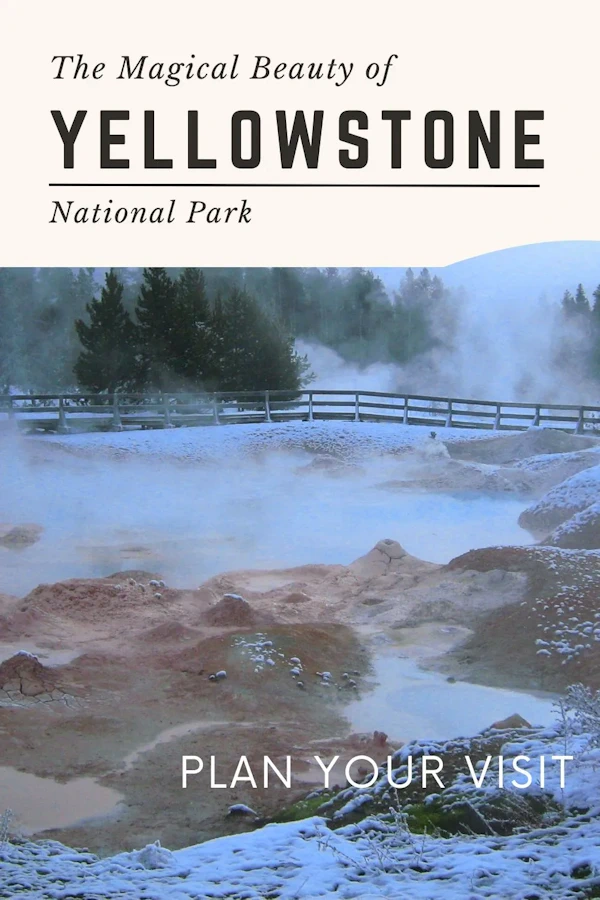
- At 3,472 square miles Yellowstone Park is larger than Delaware and Rhode Island combined.
- There are more than 10,000 hydrothermal features in Yellowstone.
- Yellowstone contains more than 500 active geysers.
- Yellowstone is home to the largest concentration of mammals in the lower 48 states (67 species).
- Yellowstone has more than 290 waterfalls.
- Yellowstone contains more than 1,449 kilometers (900+ miles) of hiking trails.
- The highest point in Yellowstone is Eagle Peak at 11,358 feet.
- The lowest point in Yellowstone is Reese Creek at 5,282 feet.
- The highest recorded temperature in Yellowstone was at Mammoth Hot Springs in 2002; 99ºF.
- The lowest recorded temperature in Yellowstone was at West Entrance, Riverside Station in 1933; -66ºF.
- There is a long canyon (the "Grand Canyon of the Yellowstone") in Yellowstone - an important example of river-type erosion - approximately 24 miles (39 km) long, between 800 and 1,200 ft (240 and 370 m) deep and from 0.25 to 0.75 mi (0.40 to 1.21 km) wide. On the ridge of the canyon lies Artist Point, which offers one of the most beautiful views in the park.
- The United States only has 26 UNESCO sites across the entire country, and Yellowstone is one of the most important.
Where is Yellowstone National Park? Map
For our first trip to Yellowstone, we had been skiing at Big Sky, MT and decided to drive down to Yellowstone to see the park. It is a 60 mile drive from Big Sky Resort to the park and since our Snowcat tour was scheduled for early morning, we drove there the afternoon before and got a hotel.
Yellowstone is a large park that occupies 3,472 square miles. Even though the official address is to the state of Wyoming, Yellowstone is actually in three states. The majority of Yellowstone (96%) is in Wyoming. A small section of the park (3%) to the north and northwest is in Montana. And a small section of the park (1%) to the west is in Idaho. I mention this fact because you need to know where the nearest entrance is (and there are 5 entrances to the park) for your purposes. As you can see on our map, we entered via the west entrance.
Most roads inside Yellowstone National Park are closed to all automobile access (during wintertime) and only "Oversnow Vehicles" are allowed. Click here to view the National Park Page where these rules are documented.
Our game plan was to take a Snowcat tour of the park, which would terminate at the Old Faithful Snow Lodge where we could observe an Old Faithful eruption.
There is an excellent "frequently asked questions" page on the Yellowstone Park Website. They answer just about every question that you could possibly have and then they answer a few more. Click here to view that page.
Yellowstone National Park Lodging
If you are not familiar with the park, you should be aware that there are accommodations in the park, and there are accommodations near each park entrance - there are five entrances to the park: north, northeast, east, south, and west. As just an example, for our second visit to the park, we stayed in West Yellowstone near the western park entrance. This is a small town (2022 population was 1,444) and it obviously exists as a tourist center for the park. The point here is that if you are going to be staying in the park area, you need to first determine which entrance you would want to stay near.
As of 9/5/2024 Google says there are 71 hotels near the western park entrance, so if you are interested, click here to view that Google Search Results list.
Below are 5 accommodations near the western park entrance. Your requirements may necessitate you to use a broader search, but these 5 are popular.
- Explorer Cabins at Yellowstone: Ideal for a more secluded, rustic experience. These cabins provide modern amenities like kitchenettes, Wi-Fi, fireplaces, and even a s'mores kit upon check-in. The community fire pit is great for evening gatherings.
- Kelly Inn West Yellowstone: A family-friendly option located near the park's entrance. It features spacious rooms, including options with bunk beds for kids, a heated indoor pool, and a complimentary hot breakfast.
- Bar N Ranch: Located just six miles from the park, Bar N Ranch offers a unique Western-style lodge experience. It has private cabins with fireplaces, plenty of outdoor activities like horseback riding, and stunning mountain views.
- Clubhouse Inn West Yellowstone: Just minutes from the park, this hotel offers spacious rooms, an indoor pool, a hot tub, and free parking. It's close to local attractions like the Grizzly & Wolf Discovery Center.
- Alpine Motel: A budget-friendly, cozy motel with excellent service, located in the heart of West Yellowstone. It offers free Wi-Fi, private parking, and an outdoor dining area.
- Camping in the Park: These include Bridge Bay Campground, Canyon Campground, Fishing Bridge RV Park, Grant Village Campground and Madison Campground. Additional campgrounds in Yellowstone can be booked through recreation.gov.
Yellowstone Park Entrances
Given the size of Yellowstone Park, there are five entrances, so which one you enter depends upon which direction you are coming from and perhaps where you want to stay, assuming you are staying outside the park.
The cost to enter Yellowstone National Park depends on the type of pass and how you're entering the park:
- Standard Entrance Pass: $20–$35
- Annual Pass: $80 for free entrance for one year
- America the Beautiful Pass: $80 for seniors 62 and older, free for current US service members and dependents, and free for people who have volunteered with certain federal agencies for at least 250 hours
- Non-commercial groups: $12 per person for groups of 15 or more entering in a bus or vehicle
- Pedestrians: $20
- Motorcycles: $30
- Private vehicles: $35
- Children 15 and younger are exempt from paying the entrance fee. Entrance passes are non-refundable and non-transferable.
The National Park Service "Senior Lifetime Pass" is still one of the best bargains available.
| Park Entrance | Logistical Information |
|---|---|
|
West Yellowstone, Montana, is one of the busiest entrances to Yellowstone National Park and has a well-developed range of services for visitors. There are around 40-50 dining establishments in West Yellowstone. These include a mix of cafes, diners, steakhouses, pizza places, fast food options, and bars, offering a variety of American and international cuisine. West Yellowstone offers about 60-80 places to stay, including hotels, motels, lodges, cabins, and vacation rentals, as well as campgrounds and RV parks. |
|
|
The North Entrance to Yellowstone National Park, located near Gardiner, Montana, is a smaller gateway compared to West Yellowstone. There are about 10-15 restaurants in Gardiner, including cafes, grills, American diners, and pizza places. There are around 20-30 places to stay, such as hotels, motels, cabins, lodges, and vacation rentals. |
|
|
The East Entrance to Yellowstone National Park is located near the town of Cody, Wyoming, which is about 50 miles east of the park's entrance. Cody serves as the primary gateway for visitors entering through the East Entrance. Cody has around 30-40 restaurants, offering a variety of options like steakhouses, cafes, fast food, American-style diners, and some international cuisine. Cody has about 40-60 places to stay, including hotels, motels, lodges, bed-and-breakfasts, cabins, and RV parks. |
|
|
The Northeast Entrance to Yellowstone National Park is near Cooke City and Silver Gate, Montana, which are much smaller and more remote compared to other entrances like West Yellowstone or Cody. Cooke City and Silver Gate, there are around 5-10 dining options. These include cafes, bars, grills, and small local eateries, but the options are limited due to the remote location. There are around 10-15 places to stay, including small motels, cabins, lodges, and vacation rentals. Some campgrounds are also available in the area. |
|
|
The South Entrance to Yellowstone National Park is located near Grand Teton National Park and Jackson, Wyoming, which serves as the primary gateway for visitors entering from the south. The South Entrance itself is remote, but Jackson, a popular tourist destination, offers a wide variety of services. Jackson has about 80-100 restaurants, offering a wide range of dining options, including fine dining, cafes, steakhouses, international cuisine, fast food, and bars. There are around 100-150 places to stay in Jackson, including hotels, motels, luxury lodges, cabins, vacation rentals, and campgrounds. |
Yellowstone Snowcoach Tour
There are several operators that offer snowcoach tours in Yellowstone National Park, including:
- Backcountry Adventures: They offer snowcoach tours in comfortable 12-passenger VanCoaches.
- Yellowstone Vacation Tours: Offers guided snowcoach tours, as well as bus and snowmobile tours.
- Yellowstone Alpen Guides: Offers snowcoach and snowmobile tours with experienced guides.
- SeeYellowstone: Offers guided snowcoach tours, as well as lodging, equipment rental, and clothing.
- Yellowstone National Park Lodges: Offers daily snowcoach transportation between Mammoth to Old Faithful Snow Lodge.
We utilized Yellowstone Vacation Tours, only because of our schedule & their availability. All of these companies support each other when necessary. Please note that the above is not the "complete list of snow coach tour companies", click here to view a Google Search Results list of all snow coach tour operators.
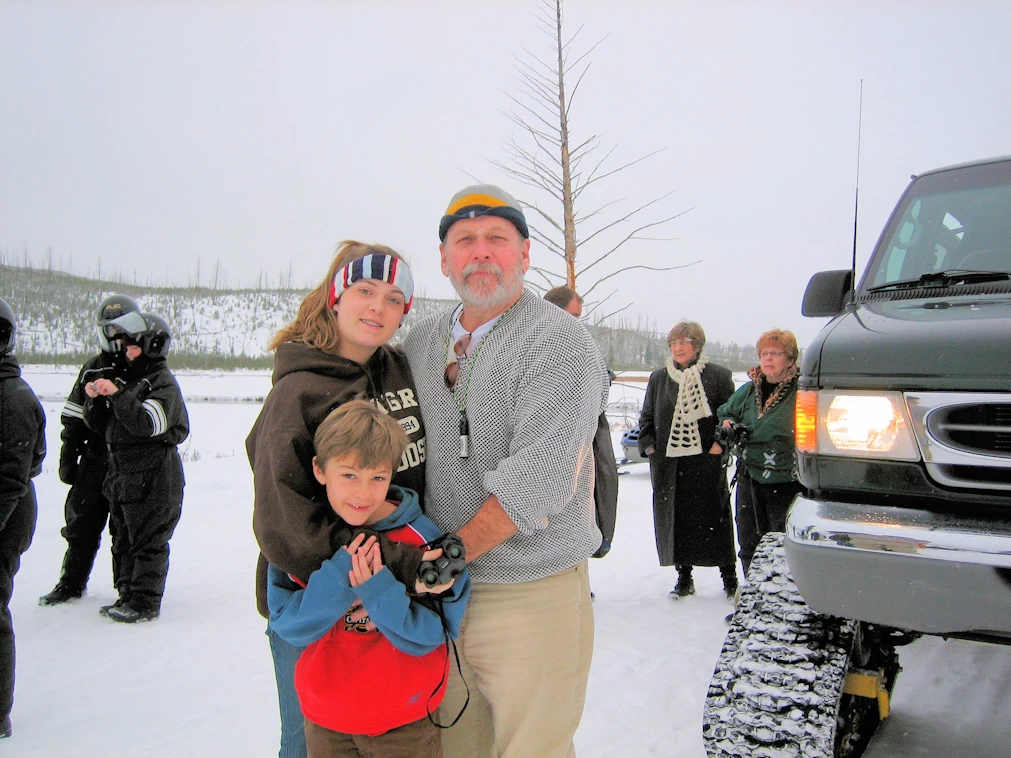
Snowcat (Snowcoach) Reliability
After our Snowcat tour had been on the road for several hours, it snapped the "axle to track" shaft. Here we are after waiting for a new Snowcat to come and get us. The one we were on for our tour of the park requires track repairs and so everyone had to wait until they could send us a new vehicle.
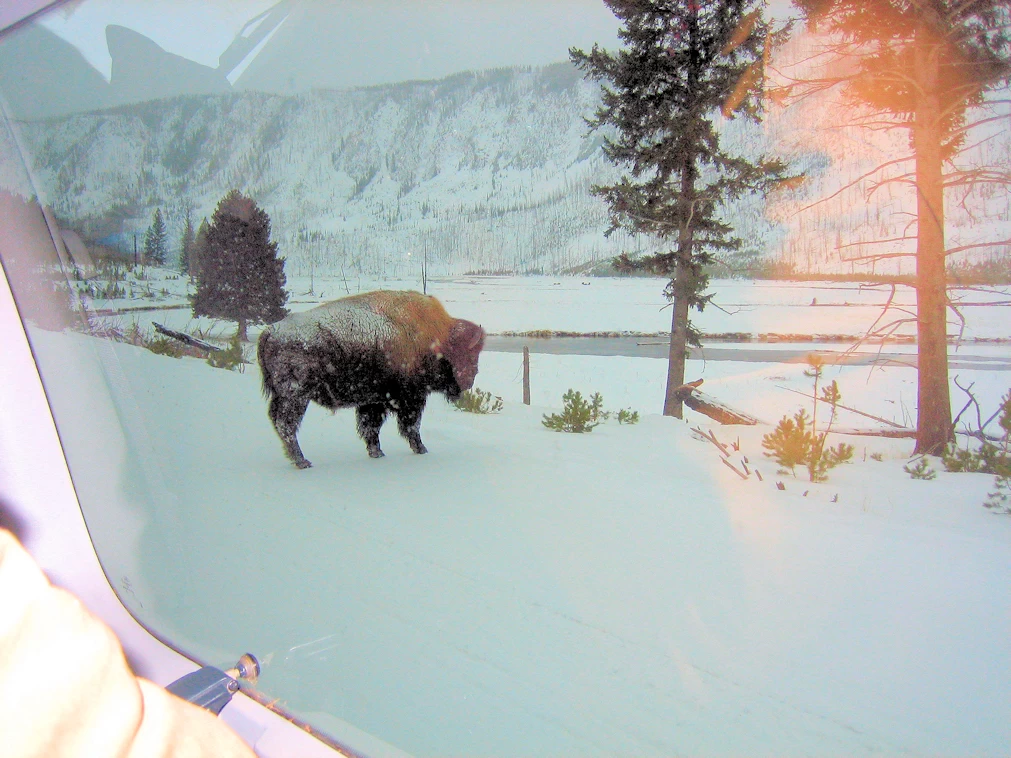
Bison are Everywhere
The bison in Yellowstone, were obviously dressed for the weather, and were no doubt much warmer than we were! Of course when you are over six feet tall and weight in excess of 2,000 pounds and wear a heavy fur coat, staying warm is easier for them than for humans!
There were several large bison herds that our snow cat drove by, these guys were everywhere. And as you can probably see, this picture was taken from inside the snowcat, as Bison are tempermental and sometimes take exception to humans approaching them on foot. Bison are the largest land animals in North America, weighing up to 2,000 pounds. This immense size and strength make them incredibly powerful and capable of inflicting serious injuries, even with a seemingly minor swing of their head or horns.
NOTE: Approaching bison is illegal in all national parks, including Yellowstone National Park. Park rangers actively enforce these regulations to protect both visitors and the animals themselves.
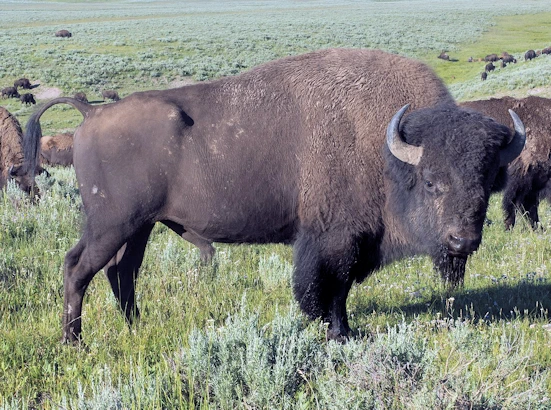
Park Bison Herd
There are approximately 5,000 buffalo in the Park, but the National Park Service (NPS) has a program that reduces the herd size each year. This is a controversial program because bison were nearly extinct at one point. The NPS program faces public scrutiny from various groups. Some believe bison populations should be allowed to expand naturally, while others prioritize protecting livestock and human safety. Balancing these diverse perspectives requires ongoing dialogue, research, and adaptation of management strategies.
IMAGE CREDIT: Above image is the property of ISteeve via Wikimedia Commons using the Creative Commons CC BY-SA 3.0 DEED license.
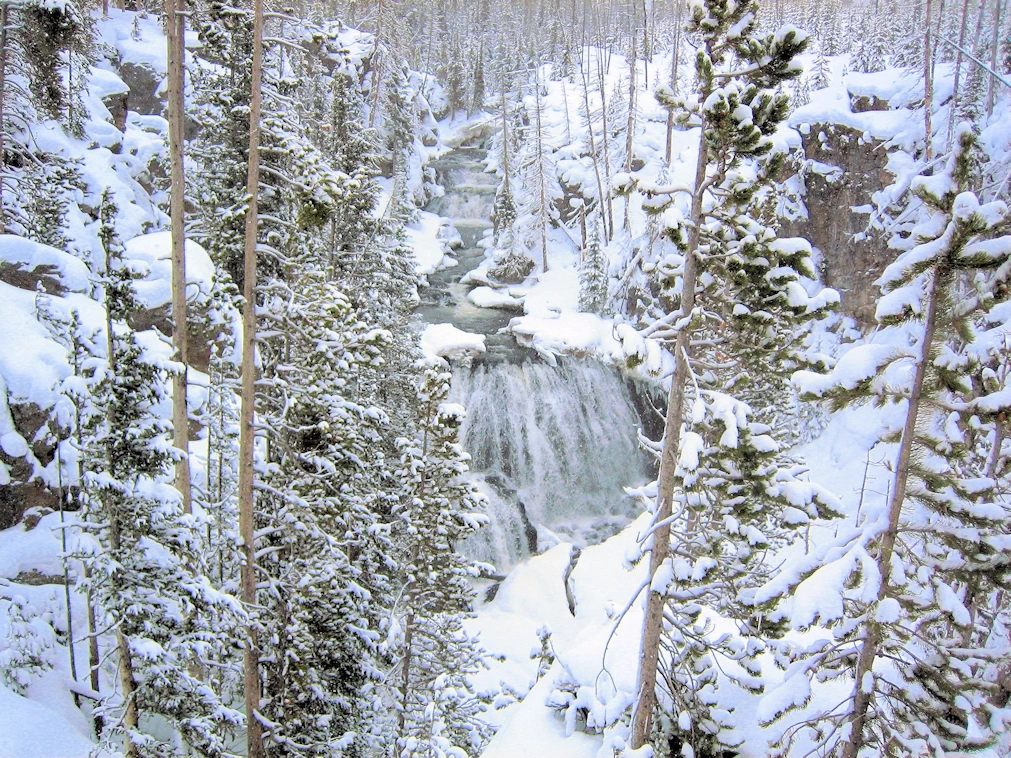
Yellowstone Geography
Throughout Yellowstone Park the geography is highly variable, and as you can see, very rugged country. 96% of Yellowstone's land is within the state of Wyoming, while 3% is in Montana and 1% is in Idaho. Rivers and lakes make up 5% of the park's land area and the largest body of water in Yellowstone is Yellowstone Lake, which covers 87,040 acres and is up to 400 feet deep. Yellowstone Lake has an elevation of 7,733 feet which makes it the highest altitude lake in North America. The remainder of the park is mostly covered by forest and a small percentage of grassland. Mountains and deep canyons also dominate much of Yellowstone.
The park covers an area of 3,472 square miles (8,987 sq km) that is made up of various geothermal features like geysers, as well as mountains, lakes, canyons, and rivers.
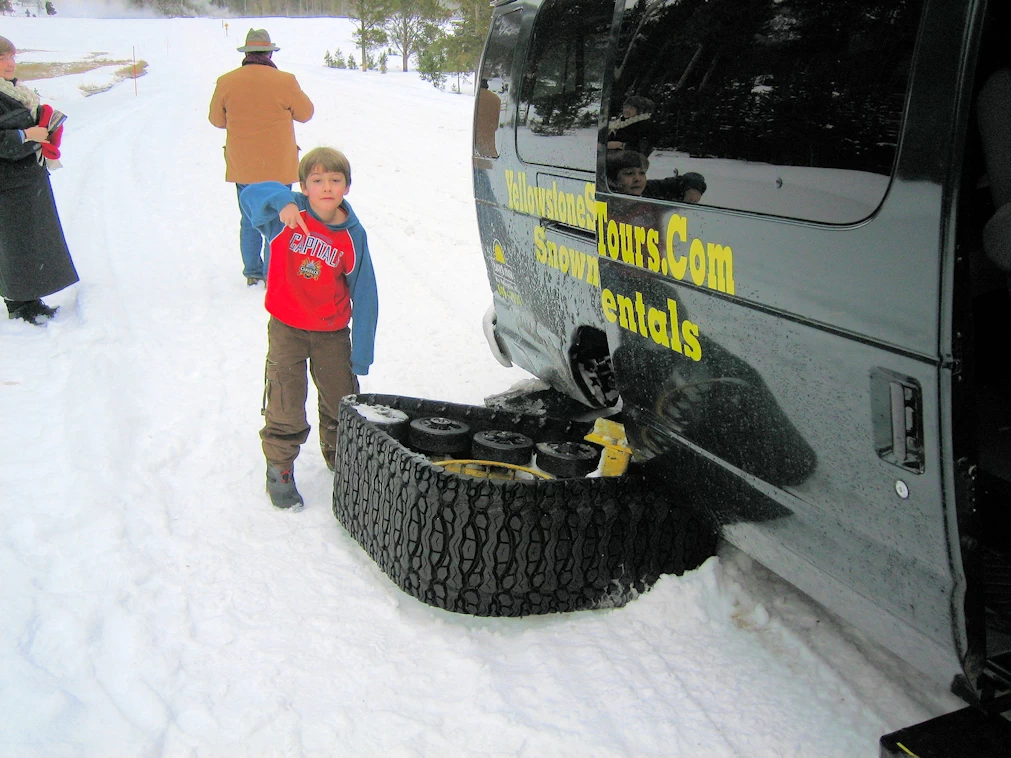
Snowcat Failure
Did I mention our snow cat broke down? As you can see in this image , the track mechanism has completely sheared off from the drive axle. These parts are expensive; there are two manufacturers of these track systems - one is named "Track N Go" and the other is named "Mattracks" and the prices range from $25,000 to over $50,000.
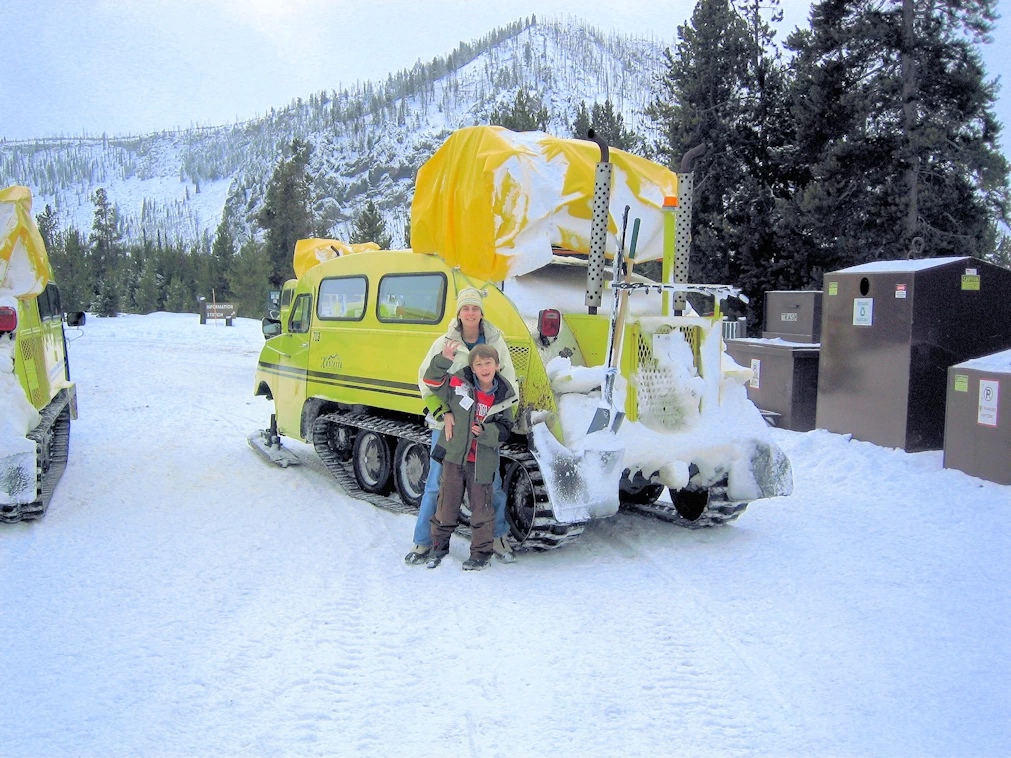
New Snowcat Requested
Since the original Snowcat was going to require a new axle, the driver had radioed in and had the tour company send out a replacement snowcat. That was good news indeed, because as you can see, the snow and cold were not going to get better anytime soon.
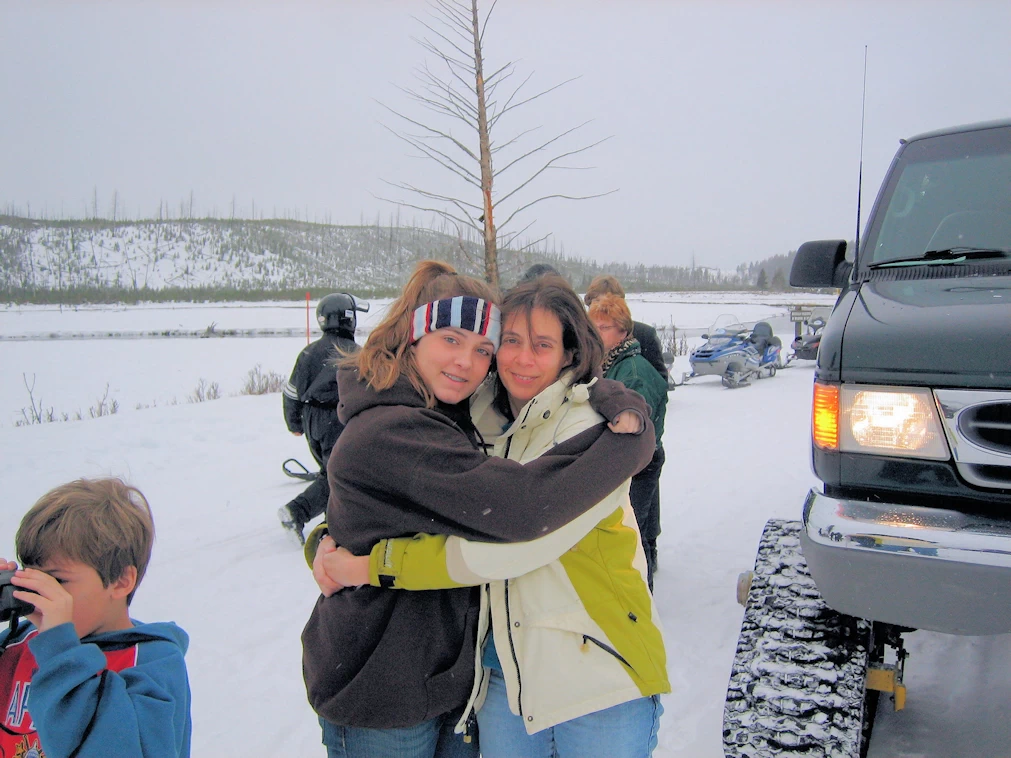
New Snowcat Arrival!
Everyone is celebrating the new snow cat arrival, as we knew that it was going to be warm inside!

Lets go visit Yellowstone Park
We decided to take everyone up to Yellowstone, and because we wanted to take a sno-cat tour, we got a motel for one night. The next morning, it was minus 27 degrees! I cannot put into words how cold it felt!
Even though it is only 104 miles from Driggs, ID to Yellowstone Village, we thought that it would be more fun to drive up the day before, because all of the Snowcat Tours all get an early start.

Yellowstone Snowcat Tour
Everyone is enjoying the Snowcat tour, and by now, it had "warmed up" to zero degrees. Fascinating how good zero degrees felt after we had experienced -27 degrees!
The Snowcat would stop at various places, and we would all get to go out and explore that area. Chelsea is explaining that it is really cold. The inside of the Snowcat would warm up in between stops, but the would get very cold inside while everyone went outside to explore.

Yellowstone Geography
Yellowstone is full of geysers, bubbling hot springs, bubbling mud pools, and everywhere you look is steam rising from ponds or streams. Click here to read more about the Yellowstone Caldera and find out about the gigantic volcano that lies beneath the park.
Yellowstone Park Steam Sources
Everywhere you look in the park, you will see steam rising from the ground or the water. The entire Yellowstone area sits atop an ancient caldera referred to as the Yellowstone Super Volcano. This massive volcanic depression, measuring 43 by 28 miles, formed over 2 million years ago during a cataclysmic eruption. Though dormant for millennia, it's classified as a supervolcano, capable of unleashing an event over 1,000 times more powerful than the 1980 eruption of Mount St. Helens.
Covering an area of roughly 2.2 million acres, the Yellowstone Caldera is characterized by a vast, sunken volcanic crater. The supervolcano has had several major eruptions in its geological history, the most recent being around 640,000 years ago. These eruptions were among the largest on Earth, with the potential to cause global climatic impacts.
Today, the Yellowstone Caldera remains geothermally active, resulting in the park's famous geysers, hot springs, and geothermal features. The most iconic of these is Old Faithful, a reliable and frequent geyser. These geothermal phenomena offer a glimpse into the immense geological forces lurking beneath the Earth's surface.
Quick Facts: The Yellowstone caldera formed during the last of three super eruptions over the past 2.1 million years: the Huckleberry Ridge eruption 2.1 million years ago (which created the Island Park Caldera and the Huckleberry Ridge Tuff); the Mesa Falls eruption 1.3 million years ago (which created the Henry's Fork Caldera and the Mesa Falls Tuff); and the Lava Creek eruption approximately 630,000 years ago (which created the Yellowstone Caldera and the Lava Creek Tuff).
The above information was extracted from Wikipedia, click here to view their page.
Old Faithful
Eventually the Snowcat tour brought us to the Yellowstone Visitor Center, where we got to see the most famous geyser of them all. The period of time between Old Faithful's eruptions ranges from 35 to 120 minutes, though the average is 92 minutes. About 90 percent of eruption predictions are accurate within a window of plus or minus 10 minutes.
Old Faithful's eruptions are fueled by the Yellowstone Caldera, a supervolcano slumbering beneath the park. Superheated water, trapped within the Earth's crust, rises towards the surface and eventually explodes upwards, creating the geyser's spectacular display. Each eruption is a unique spectacle. Towering plumes of water, sometimes reaching 180 feet, billow into the air, carrying with them steam, minerals, and a sense of raw power. The surrounding air vibrates with the roar of the geyser, and the ground trembles with its energy.
Here we are walking over to the Old Faithful viewing area, waiting for it to put on a show. This area is directly in front of the Yellowstone Park facilities, including; Old Faithful Lodge, Old Faithful Cafeteria and Visitor's Center. Gave us a chance to use the restrooms and grab a snack.
The Geyser is working up to generate the "full blast", so there are frequently some initial smaller displays until the full display starts.
New Snowcat is Ready
I thought that I better check the Snowcat hardware, to make sure it is ready to take us again. For the record, the park does not allow automobiles to traverse the roads in the winter, only these Snowcats and snow-mobiles are allowed to use the roads.
Because these track systems are fitted to vehicles that began life as a regular wheeled vehicle, they are perhaps not as robust as would otherwise be required. Conveying a number of people around the park, on roads that are rough due to snow & ice, I am amazed that break-downs are not more frequent than they are.
Waiting for the Old Faithful Eruption
Not sure whether we are discussing how cool Old Faithful is, or maybe how much warmer it feels at 3 degrees than it did at -27 degrees. The real answer is that you have to get in position prior to the geyser eruption in order to get a decent spot, because the crowd gets larger prior to the show.
Old Faithful erupts approximately every 60 to 110 minutes. On average, the interval between eruptions is about 90 minutes. The timing between eruptions can vary based on factors like the duration and volume of the previous eruption. Shorter eruptions generally lead to a shorter wait time for the next eruption, while longer eruptions result in a longer interval before the next one.
Old Faithful Quick Facts: Old Faithful is a cone geyser located in Yellowstone National Park in Wyoming, United States. It was named in 1870 during the Washburn-Langford-Doane Expedition and was the first geyser in the park to receive a name. It is a highly predictable geothermal feature, and has erupted every 44 to 125 minutes since 2000. The geyser and the nearby Old Faithful Inn are part of the Old Faithful Historic District.
The above information was extracted from Wikipedia, click here to view their page.
The National Park Service live streaming webcams can be viewed by clicking here. The Old Faithful Geyser webcam is at the top of the page, all others can be seen by scrolling down.
Yellowstone Bison Herds
There were a number of Bison herds in Yellowstone, and none of these guys seemed to feel the cold like we did! The bison pretty much wandered where ever they wanted to, including sometimes marching down the center of the road. The Snowcat driver told us that they were required to pull over and park on the side until the bisons would finish walking by, or the bison would take offence and attempt to put a horn into the Snowcat!
Quick Facts: An estimated 20 to 30 million bison once dominated the North American landscape from the Appalachians to the Rockies, from the Gulf Coast to Alaska. Habitat loss and unregulated shooting reduced the population to just 1,091 by 1889. Today, approximately 500,000 bison live across North America, including approximately 5,000 in Yellowstone Park.
The above information was extracted from Wikipedia, click here to view their page.
Some Useful Links for Yellowstone National Park
- Just Traveling Thru European Travel Tips
- Just Traveling Thru Travel Planning Tips
- Yellowstone National Park History on the 'Britannica' site
- 15 Best Yellowstone Tours from the 'Crazy Tourist' site
- Complete Guide to Yellowstone National Park from the 'Lonely Planet' site
- Google Search Results list for "Restaurants near Yellowstone National Park"
- Google Search Results list for "Accommodations in/near Yellowstone National Park"
- National Park Service page for "Yellowstone National Park"
- Yellowstone National Park Website
- Amazon Search Results list for "Yellowstone National Park"
- Youtube Search Results list for "Yellowstone National Park"
- Yellowstone Full Day Tour from the "Get Your Guide" site
- Great Short Hikes in Yellowstone National Park on the "Yellowstone" site
Note: All images featured on this page are the exclusive property of Just Traveling Thru, LLC, unless otherwise stated. When images from external sources are used, full credit is given to the original creator, along with a link to the specified license or usage terms. We are committed to respecting copyright and intellectual property rights, ensuring that all third-party images are properly attributed. If you have any questions regarding image ownership or usage rights, please feel free to contact us.
To review any of our content, make suggestions and/or comments, please click the "About" menu link at the top of this page. You will find our "Contact Us" link on that drop-down menu.

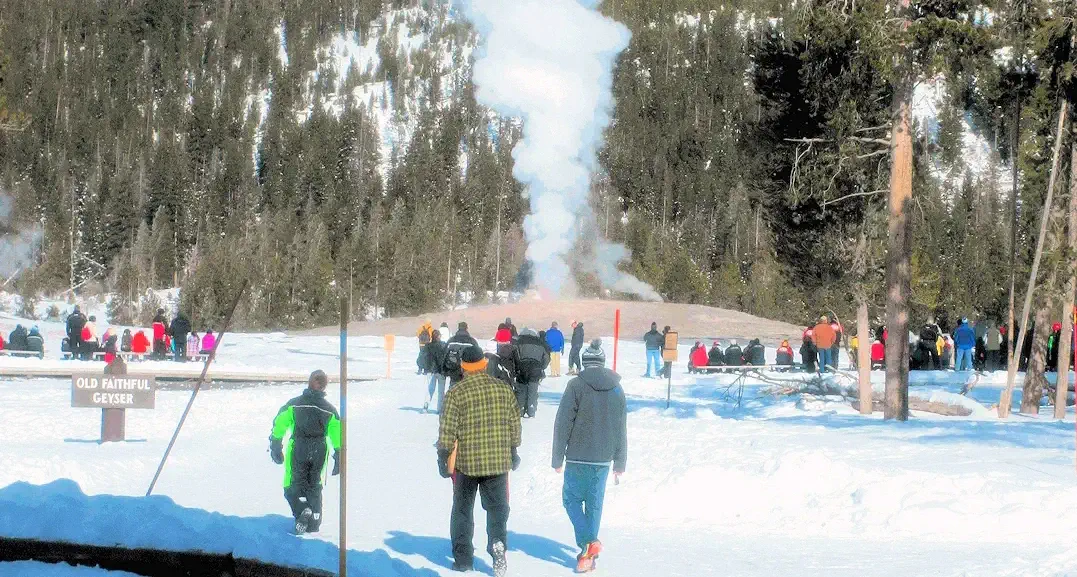



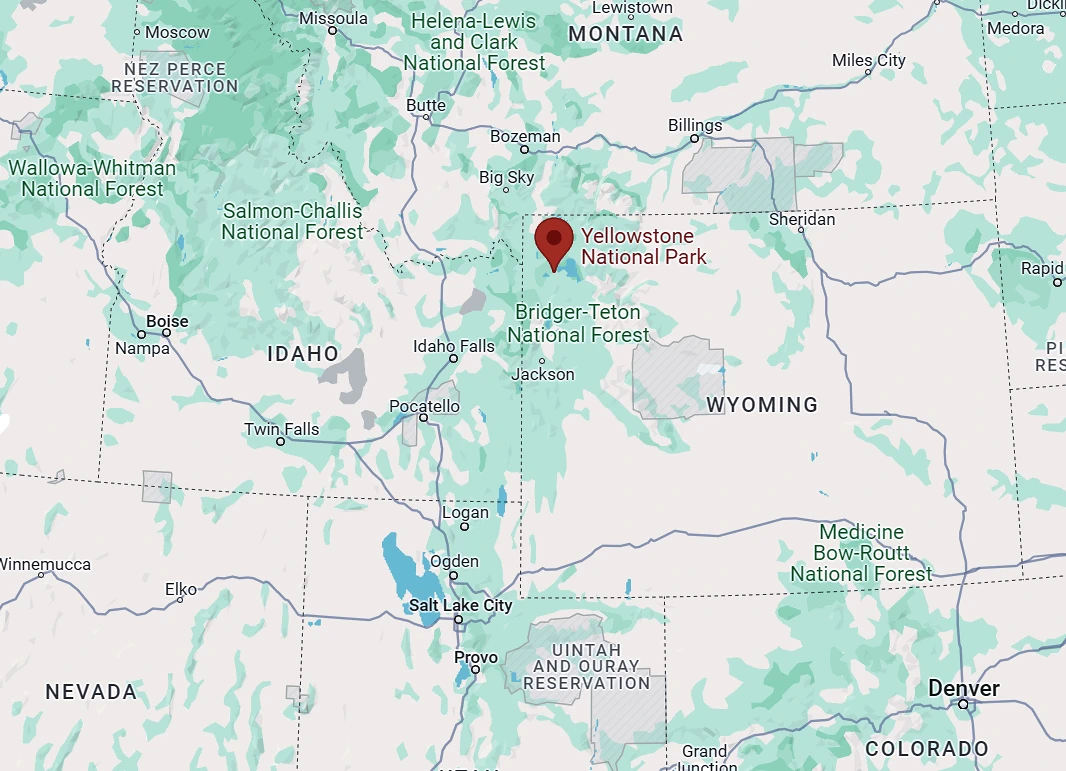 Click Above Image to view a Google Map
Click Above Image to view a Google Map
